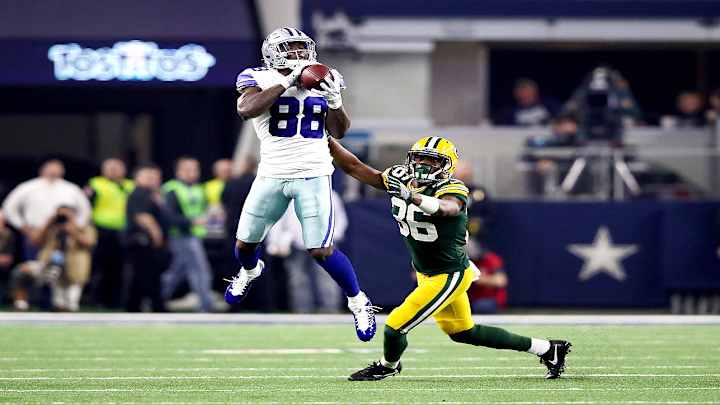The Art of a Successful Fantasy Football Trade

The fantasy season doesn’t end when your draft is done. Neither should your obsessive watch over your roster. Strong in-season management is often more indicative of a championship team than a good draft, and trading is a large component of what a successful fantasy owner must do during the regular season. Here are our best practices for winning a fantasy football trade.
1. Buy low and sell high based on strength of schedule
Matchups are something many fantasy owners forget to account for, and understanding them is a great way to gain an edge. Few players are capable of posting top fantasy numbers every single week. In fact, most of them are no better than a 50/50 bet to give you usable fantasy production in a given week. Matchups make all the difference. Many players ball out at home or against bad defenses, but are no better than average otherwise.
It's jarring for owners to watch a player for which they had high hopes sink their lineup multiple times early in a season, and many end up trying to unload the player in question. If tough matchups can explain the down weeks, be ready to pounce, especially if the schedule will let up. For example, Dez Bryant is known to struggle against top cornerbacks. He starts 2017 against Janoris Jenkins, who helped limit him to two catches on 14 targets in two games last year. Then he faces the Broncos and Aqib Talib, followed by the Cardinals Patrick Peterson. Would you be surprised if he had a quiet first three weeks? If he does, plenty of owners will be looking to sell their second-round pick.
At the same time, be careful not to overvalue your own players. Have someone that posted an unexpected flurry of big weeks? Make sure it wasn't only because he enjoyed a bunch of easy matchups. If so, aim to sell high unless his upcoming matchups are also soft. Having a hard time with determining true matchup strength? Use something like the 4for4 Before & After Strength of Schedule tool.
Be aware of future matchups when determining player value. Have a player with a tough upcoming schedule? Try to flip him for a player of similar value with an easier one. And remember, a trade may not be as good as it first looked if the player you'll receive has tough matchups on tap. If you already have a playoff spot sewn up, target players with good fantasy playoff matchups. The 4for4 Playoff Matchup Planner is an invaluable tool for this.
How to Draft Like a Fantasy Football Expert
2. Trade depth for studs close to the deadline
Early in the season, depth is a priority. You’ll need it to handle bye weeks, injuries and unexpected busts. As the season wears on, the largest amount of time a player could miss due to injury shrinks. You also have a better idea of player value in general. You want a starting lineup with as many studs as possible for the stretch run, so be willing to sell your depth.
Start your process with the worst teams in your league. They'll often be low on startable options and be willing to give up a stud for a few pieces of serviceable depth.
The only spot to be cautious about trading depth is at running back. Make sure you have at least one extra back on your roster you would be able to start at all times. Backs get injured more than other positions and are the most difficult to replace via the waiver wire.
3. Throw in replaceable players to sweeten the deal
Remember, almost every player is matchup-dependent. This is especially true for kickers and defenses. Even if you have one of the best ones in the league, you can find replaceable production on the waiver wire. For example, as good as the Broncos defense was last year, it was a below-average fantasy unit as an underdog. Meanwhile, an average defense like Lions had its fair share of above-average fantasy games as a favorite. If a Stephen Gostkowski or Seahawks defense is what it will take to move the needle, make it happen. And, in general, be willing to trade away players at one-starter positions for back or receiver depth.
4. Value unbalanced deals correctly
Many owners decide a trade's fairness by comparing fantasy points of players involved. But players are more valuable at positions where you need to fill more than one starting slot. In unbalanced deals, one stud can be worth more than two players who equal his fantasy points. When in doubt, use a tool like the 4for4 Trade Analyzer.
Should I Draft Dalvin Cook or Ty Montgomery in 2017 Fantasy Football Drafts?
5. Don’t ruin your reputation by sending out a lot of bad trade offers
Sometimes playing the numbers game makes sense. Sending your resume to as many prospective employers as possible? Go for it. Buying a bunch of lottery tickets? Negative expected value, though there's still some upside. But dangling your injured fourth-string running back to every single owner in your league? Not a good move. You want your leaguemates to trust you. If they don't, they may not pull the trigger on a deal with you down the road, even if it’s more than fair. If they do, they may give you the benefit of the doubt even when a trade helps you more than them.
Bonus: Always counter even the most insulting trade offers
If an owner is thoughtless enough to send you an insulting offer, he or she may also lack the savvy to reject one in your favor.
